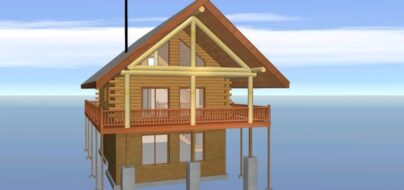1. Know Your Budget
How much can you afford? How much do you want to spend? Or how much should you spend? If you are looking at the home as an investment for future turn-over, you may not want to build a log castle on a city lot. If this is your dream and you plan on living there a long time, then you plan for that. Looking at resale is always good with any home purchase. You should write out your plans and discuss them with your spouse, investment partner, banker and financial advisor. Be practical and allow for unforeseen expenses. Consider how much of the work you will be doing yourself. This could allow you to go larger on the home or buy a nicer piece of property.
2. Purchase Land
For some this step may come at different times. The obvious point is that you will need some land to put your home on.
3. Decide On A Plan
Once you know your budget you can begin to look for a plan. You can get estimates on different plans to figure out the basic size and style of home that will work within your budget. Some folks have been working on this step most of their life, hence the dream. The design process of finding and working with the home style and floor plan that’s right for you can be painstaking. However, this is probably the most important part of the process.
4. Decide On A Log Home Provider
Sometimes finding the provider first can help put some of the other steps in order. The company you decide to buy your log package from should be able to:
- Either build your home or put you in touch with a builder.
- Help you find the right style you are looking for according to your budget, needs, and dreams.
- Supply quality products of the style you have chosen within your budget.
5. Find A Builder
In some cases the log provider is the builder, but you may need to find a contractor / builder. Most log home companies only provide the materials to complete the project. Your log provider should have a network of builders and other contractors and know their qualifications. As the customer, you would be responsible for contracting with the builder and should always check out who you are going to be dealing with for the next one to two years or even longer on some projects.
6. Get Your Permits
Check with your local township and get the paper work for their specific building and inspection process. Find out what type of septic and well you will need for your area. This should be one of your first steps as some areas have specific sizes for homes and septic sizes. Drive around and get the names of other homeowners and builders in your area. Most often they would be happy to share their success story. Tell them you would like to build a log home and ask them for names and numbers of contractors in the area.
7. Hire Someone To Put The Foundation In
The best time to find a foundation contractor is in the off-season. So begin early to secure your spot for when the frost leaves the ground. If you have a builder, he may already have a subcontractor lined up that he likes to work with.
8. Order Your Log Package
Order the log portion of your package as soon as possible to ensure that your logs are cut, peeled and dried when you’re ready for them. At Classic Log Homes, Inc. we are able to provide high quality log products and save you money on your log home by cutting your package to order. We use small, family owned log mills with low overhead and we don’t have a large advertising budget. We are then able to pass the savings on to you. Your best savings comes from our air dried, natural peeled logs. We also have more modern milled, kiln dried, and true handcrafted log packages to fit your budget and individual taste for your one-of-a-kind dream home.
9. Compare Products and Prices With Other Companies
At Classic Log Homes, Inc., the cornerstone of our business is exceptional quality products and services at lower prices. We are confident that you will get larger, higher quality logs for less. So we encourage you to compare with our competitors.
10. Learn More
If you want to really learn and study for your log home project, we suggest checking out the following web sites:
Check out these two online stores for tools, hardware, books, caulks, stains, and problem solving:





